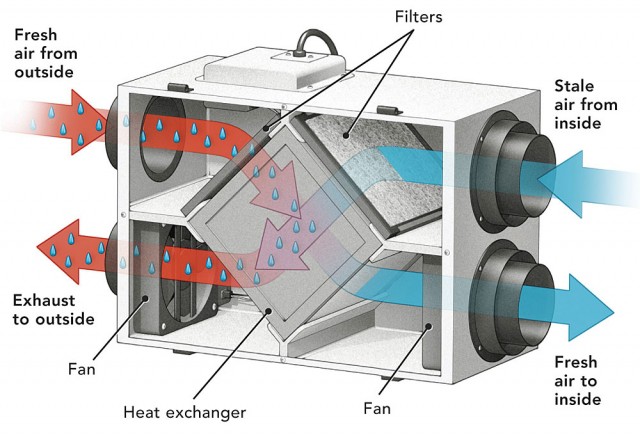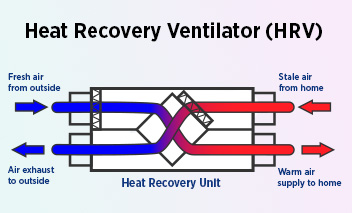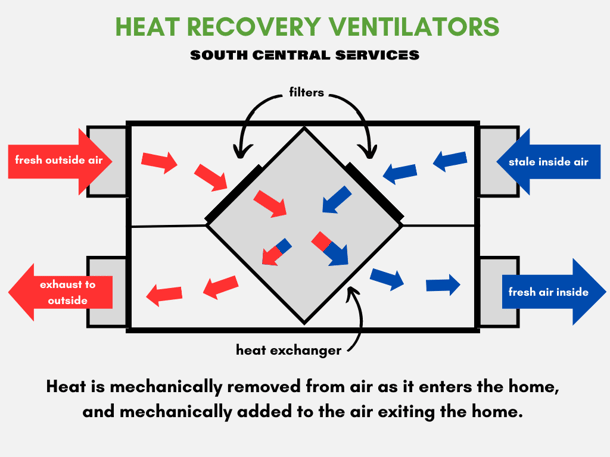The All-Inclusive Overview to the Uses of Heat Recovery Ventilation in Modern Structures
Heat Recovery Ventilation (HRV) systems represent a substantial improvement in developing technology (HRV Heat Recovery Ventilation). They provide a technique for exchanging stagnant interior air with fresh outside air while minimizing energy loss. This approach not only boosts indoor air top quality however additionally contributes to power efficiency in both household and commercial structures. Recognizing the different applications and advantages of HRV can reveal its essential role in modern-day design and sustainability efforts. The effects of this technology deserve exploring additionally
Understanding Heat Recovery Ventilation Solutions

Numerous contemporary buildings prioritize energy effectiveness, recognizing warmth recovery ventilation (HRV) systems is important for enhancing indoor air quality and minimizing power intake. HRV systems work by transferring warmth from stale interior air to inbound fresh air, effectively keeping comfortable indoor temperatures while decreasing power loss. These systems include a warm exchanger, followers, and ductwork that promote the circulation of air. Throughout wintertime, HRV devices record and recycle heat from the outgoing air, while in summer season, they can assist cool down incoming air. By continually exchanging air, HRV systems likewise minimize moisture and the concentration of interior toxins. Correct installation and maintenance of HRV systems are necessary for their efficiency and effectiveness in enhancing general building efficiency and comfort.
Benefits of Heat Recovery Ventilation
Heat recovery ventilation systems offer many benefits that boost both energy performance and interior air quality in modern-day structures. By catching and reusing power from exhaust air, these systems substantially minimize cooling and heating costs, leading to reduced power usage. In addition, they preserve a stable circulation of fresh outside air, reducing the threat of indoor air pollutants and irritants. This continuous exchange aids regulate moisture degrees, stopping mold growth and guaranteeing a much healthier living atmosphere. Additionally, HRV systems add to sustainability goals by decreasing general carbon footprints. Their capability to maximize ventilation without giving up thermal comfort makes them a useful enhancement to contemporary building style, advertising both economic and environmental advantages.
Applications of HRV in Residential Buildings
As house owners increasingly prioritize power performance and indoor air top quality, the applications of heat recovery air flow (HRV) systems in household buildings have ended up being extra prevalent. HRV systems are especially valuable in firmly sealed homes, where preserving fresh air blood circulation is necessary for stopping moisture accumulation and interior toxins. They successfully transfer heat from outgoing stagnant air to incoming fresh air, lowering energy prices learn this here now connected with cooling and heating. In addition, HRVs can improve comfort degrees by managing humidity and temperature level. They are also adaptable for different household layouts, consisting of single-family homes and multi-unit buildings. In general, integrating HRV systems supports sustainable living practices while making sure a much healthier interior setting for owners.
HRV in Industrial and Commercial Settings
In industrial and industrial settings, the application of warm recuperation air flow (HRV) systems has actually come to be progressively critical for optimizing power performance and maintaining air high quality. These systems successfully transfer warm from exhaust air to incoming fresh air, reducing the need for added home heating or cooling. This not only decreases power prices yet additionally contributes to sustainability initiatives. Industries such as production, warehousing, and office complex benefit considerably from HRV systems, as they assist control temperature level and humidity levels, making certain a comfy and efficient atmosphere. Additionally, HRV systems help in getting rid of contaminants and excess wetness, enhancing indoor air quality. As laws around air high quality come to be more stringent, the adoption of HRV innovation is likely to grow, making it my link a vital component of contemporary commercial and industrial framework.
Future Patterns in Heat Recovery Ventilation Modern Technology

Frequently Asked Concerns
Exactly How Does Heat Recovery Ventilation Impact Indoor Air Top Quality?
Heat recovery ventilation substantially boosts indoor air top quality by constantly exchanging stagnant indoor air with fresh outdoor air while recovering energy. This procedure lowers contaminants, maintains perfect moisture degrees, and ensures a much healthier atmosphere for passengers.
Can HRV Equipments Be Mounted in Existing Structures?
HRV systems can undoubtedly be mounted in existing structures. Retrofitting might need adjustments to ductwork and ventilation formats, yet it significantly improves energy effectiveness and interior air quality, making it a practical option for older frameworks.
What Maintenance Is Needed for HRV Systems?

Are There Specific Climates Where HRV Is Extra Reliable?
Heat recovery ventilation systems are especially effective in environments with significant temperature differences between periods. These systems optimize power performance by recovering heat from exhaust air, making them perfect for both chilly and moderately warm settings.
How Do HRV Equipments Affect Energy Expenses?
